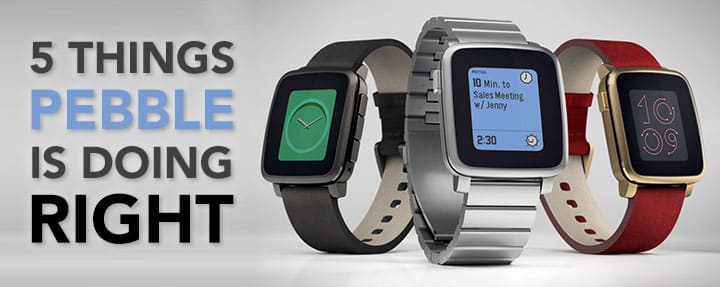Recently, Pebble has taken out a $5M loan and $5M line of credit with a Silicon Valley based bank, even though it raised $20M ($18M after fees) as the largest Kickstarter project of all time.
TechCrunch speculated that the wearables company is somehow in trouble, especially now that Apple — a 20-ton behemoth of a company if there ever was one — is entering the market. We couldn’t disagree more — Pebble is doing a lot of things right, and that’s one of the reasons we’ve integrated our MeetingPulse software with the Pebble smartwatch.
We think Pebble is going to be a major player in the wearables market for years to come. Even with Apple in the same space. Here’s why:
1. They are growing rapidly
Especially in tech, growing rapidly is the sign of a healthy company – companies that grow too slowly risk losing technological advantages. And while $18M raised in one of the largest crowdfunded campaigns ever is good initial capital, it’s especially important for Pebble to keep growing now that Apple has entered the smartwatch market. They should seek to expand production capacity, technical skill, and brand footprint. All of these require additional capital investment.
Right now, Pebble has 25 open jobs listed on their website. This does not sound like a company that desperately needs money to stay afloat – this sounds like a company that is ready to take on bigger challenges.
2. They take calculated risks.
Pebble decided to take out a business loan instead of relying on finding a VC. It was probably the right call, all things considered. Giving away an equity share to VC can end up very expensive to a growing company. Loans may have interest attached to them, but interest is predictable and relatively small. When it comes down to it, it can be easily paid off from revenue.
Venture capital, on the other hand, is giving away an equity share that will be worth tens or even hundreds of millions as the company gets bigger. That might not be a good deal in the long run. The loan is cheaper and risk much less value: the guys at Pebble understand risk very well. Of course, risk is a huge part of Pebble’s history.
Pebble went to Kickstarter to get their startup capital. Kickstarter campaigns may seem low-risk (certainly, they cost little-to-nothing out of pocket if you fail) but a failed Kickstarter can doom a product and company.
Because a failed Kickstarter implies one of two things: that the demand in the marketplace wasn’t there, or that you couldn’t promote your work successfully. Not only did Pebble take that risk, they succeeded by leaps and bounds — they’re the largest Kickstarter project of all time, raising more than $20M.
Related: Workplace Wearables: Why We Aren’t There Yet
3. They’ve got First Mover advantage
Sure, Pebble doesn’t have the brand name recognition of Apple; and Apple Watch is a serious competitor. But Apple is banking almost solely on name recognition to push their product. We talk about competitive differentiators; well, there’s little to differentiate the Apple Watch from its own iPhone, except that it’s smaller and comes with straps.
This is not a coincidence – Apple needed a watch sooner rather than later, to enter the market before Pebble established a foothold in it. And because they already had the technology used in the iPhone, they adapted the technology to a new area it wasn’t designed for.
On the other hand, Pebble is already working on the next generation version of the watch, the Pebble Time, which improves on the first version by incorporating better graphics (64-color vs. monochrome), an accessory port, and a microphone – advances that they incorporated after getting feedback from their customers.
4. They understand their market.
Pebble gets something that Apple doesn’t: Wearable technology plays by different rules than portable technology. Apple designed the Apple Watch for people who have already bought into the Apple ecosystem – it requires an iPhone 5 or later to use, uses proprietary wristbands, and costs about as much as an iPad Mini.
Tech-comfortable early-adopters who use Apple products and have disposable income are a small market, compared to the much larger market that Pebble is going after – the one currently dominated by the Swatch Group, Casio, Timex, etc.
In many ways, an Apple Watch fails at some features that are currently taken for granted in wristwatches generally. My current non-smart-watch doesn’t shut off its display in order to save battery life and doesn’t need to be charged nightly — because, quite frankly, the first thing a watch must do is tell time at a glance, not a swipe-and-glance.
These are inconveniences in a product that hasn’t required either charging or turning off its display since 1923. The long battery life, always-on display, and a price-point comparable to non-smart watches weren’t added to pebble as nice to haves. They were crucial features for urging people to upgrade from a non-smart watch to a smartwatch.
5. They’re easy to develop for.
Perhaps the most important thing is that Pebble has made their product extremely easy to develop for. There are no barriers between a developer and app development, no gatekeeper to approve or disapprove of a particular application. That means that new applications will come to the Pebble first.
We already see this dynamic playing out in the smartphone market – Android has often been first to market with new features simply because there were less barriers towards getting them approved or integrated.
Apple, comparatively, requires developers to jump through more hoops and halts development on applications that may interfere with Apple’s business interests. (I doubt you’ll see third-party software that allows the Apple Watch to integrate with an Android phone anytime soon, for example.)
With all these considerations, we think that it’s not only presumptuous but downright foolish to consider Pebble a struggling company or struggling product. It seems to have hit the sweet spot of affordability, efficiency, and productivity, and if it needs a bit more capital, it’s just an indicator of growth.






















